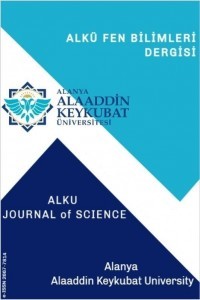Farklı Deşarj Türlerinin Seyrelme Verimliliğinin Fiziksel Modelleme Yardımıyla İncelenmesi
Sanayileşmenin artmasıyla beraber su kıyılarına çeşitli tesisler kurulmaktadır. Bu tesisler, deniz ekosistemini olumsuz yönde etkilediği bazı durumlar vardır. Bunlardan biri de ısıl deşarjlardır. Yapılan ısıl deşarjlar deniz ekosisteminde olumsuzluklar yaratabilmektedir. Isıl deşarjların oluşma nedeni; enerji santralleri, Demir-Çelik fabrikaları gibi tesislerin soğutma işlemini yapmak için deniz gibi büyük su kütlelerini soğutucu olarak kullanmalarıdır. Bu tür olumsuzlukların oluşmaması için deşarj suyunun sıcaklığına bağlı olarak alıcı ortamın sıcaklık değişimi yasalar ile kısıtlanmıştır. Bundan dolayı en iyi seyrelmeyi ve en ekonomik olan sistemin belirlenmesi önem kazanmıştır. Bunu öğrenebilmek için 3 farklı sistem laboratuvar ortamında test edilmiştir. İlk deneyimizde serbest düşen jetler, ikinci deneyimizde su yüzeyinden suya paralel jetler oluşturulmuş ve üçüncü deneyimizde ise su yüzeyine ikincil bir hazne yapılarak üç delikten deşarj yapılmıştır. Jetlerin oluşturduğu termal bulutlar incelenmiştir.
Anahtar Kelimeler:
Termal Deşarj, Deniz Deşarjı, Seyrelme, Fiziksel Model, Thermal Discharge, Sea Discharge, Dilution, Physical Model
Investigation of Dilution Performance Depending on Discharge Conditions via Physical Modelling
With the increase of industrialization, various facilities are being established on the water shores. There are some cases when these facilities negatively affect the marine ecosystem. One of them is thermal discharges. Thermal discharges can create negativities in the marine ecosystem. The reason for the occurrence of thermal discharges is that facilities such as power plants, iron and steel factories use large bodies of water such as the sea as a coolant to perform the cooling process. In order to prevent the occurrence of such negativities, the temperature change of the receiving medium depending on the temperature of the discharge water is restricted by law. Therefore, it has become important to determine the best dilution and the most economical system. In order to learn this, 3 different systems have been tested in a laboratory environment. In our first experiment, free falling jets, in our second experiment, jets parallel to the water were created from the water surface, and in our third experiment, a secondary reservoir was made on the water surface and discharged through three holes. Thermal clouds formed by jets have been studied.
Keywords:
Thermal Discharge, Sea Discharge, Dilution, Physical Model,
___
- [1] Zuuh. (2023, ocak 8). Zuuh Web Sitesi: https://www.zuuh.net/deniz-nedir-ozellikleri/ adresinden alındı
- [2] The United Nations World Water Development Report (WWDR) 2021, published by UNESCO on behalf of UN-Water
- [3] Nemlioğlu, S. (2003). Soğuk Deşarjda Birinci Seyrelmenin İncelenmesi, Doktora Tezi, İstanbul Üniversitesi Fen Bilimleri Enstitüsü, İstanbul, 1-7.
- [4] Djamaa, F. (2016). Sığ Sulara Boşaltım Yapan Isıl Deniz Deşarjlarının Birinci Seyrelmesinin İncelenmesi. Çevre Mühendisliği Anabilim Dalı. İstanbul: İstanbul Üniversitesi Fen Bilimleri Enstitüsü.
- [5] Inan, Asu & Yılmaz, Nihal. (2018). Sıcak su deniz deşarjlarının yakın alan dağılımının modellenmesi. Journal of the Faculty of Engineering and Architecture of Gazi University. 33. 875-886. 10.17341/gazimmfd.416390.
- [6] Gürpınar, E., 1995, Çevre Sorunları, 3. Baskı, Der Yayınları, No.74, İstanbul.
- [7] Su Kirliliği Kontrol Yönetmeliği. (2004, 31 Aralık). Resmi Gazete (Sayı: 25687).
- [8] Carvalho, J.L.B., Roberts, P.J.W., Ronaldo, J. (2002). Field Observations of Ipanema Beach Outfall. Journal of Hydraulic Engineering, 128(2),151-160.
- [9] Roberts, P. J. W. (1999). Modelling Mamala BayOutfall Plumes.I: Near Field.Journal of Hydraulic Engineering, 125(6),564-573.
- [10] Kanberli, M. (2003). Deniz Deşarjında Seyrelme Modellemesi, Yüksek Lisans Tezi, Gazi Üniversitesi Fen Bilimleri Enstitüsü, Ankara, 2-7.
- [11] Alıcı Ortamlara Atıksu Deşarj Standartları ve Kirletme. (2011,31 Aralık). Resmî Gazete
- [12] Gefen A. Consequences of imbalanced joint-muscle loading of the femur and tibia: from bone cracking to bone loss. In: Leder RS, editor. 25th Annual International Conference of the IEEE: Engineering in Medicine and Biology Society. Proceedings; 2003 Sep 17-21; Cancun (Mexico): IEEE; 2003; 1827-1830.
- [13] Mow, V. C., Gu, W. Y. and Chen, F. H. (2005). Structure and Function of Articular Cartilage and Meniscus. In: Mow, V. C. & Huiskes, R. (eds.) Basic Orthopaedic Biomechanics & Mechano-Biology. 3rd ed. Philadelphia, USA: Lippincott Williams & Wilkins.
- Yayın Aralığı: Yılda 3 Sayı
- Başlangıç: 2019
- Yayıncı: Alanya Alaaddin Keykubat Üniversitesi
